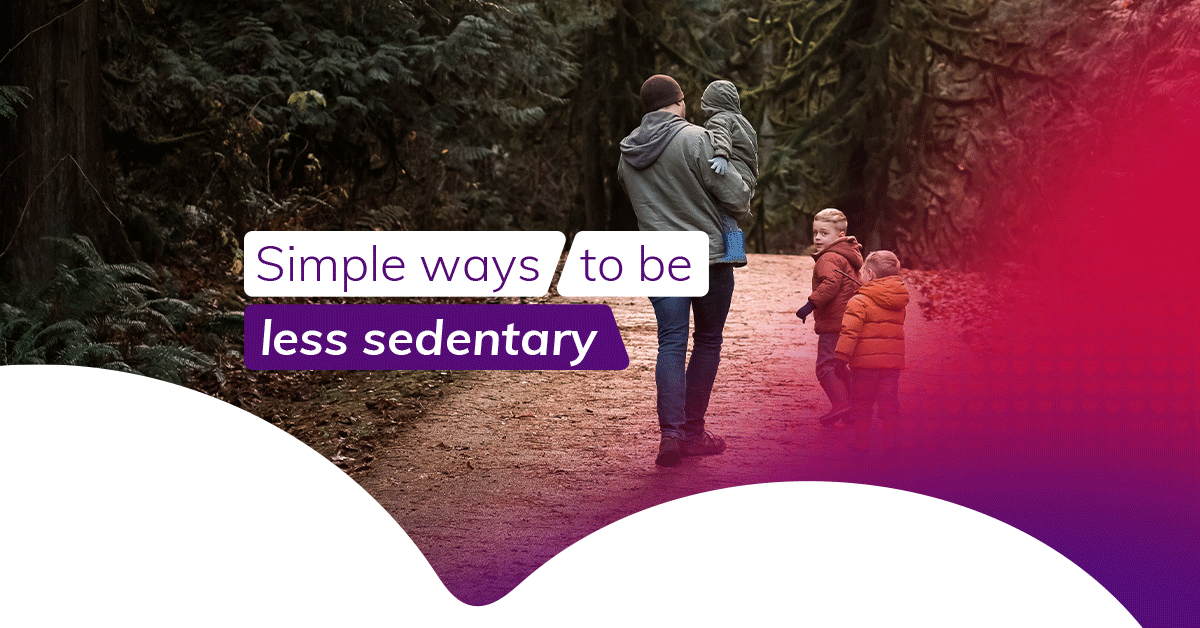

Struggle to get active at work? 5 simple steps to becoming less sedentary
Can't get your hands on a trendy 'standing desk'? Don't worry - Vhi Health Coach Dr Diarmaid Fitzgerald outlines how self-reflection, planning and small, 'five percent' adjustments can have a positive impact.
Most modern humans know – and feel – at least some of the negative effects that come from sitting in one place for most of the working day. And, along with those aches, we recognise the positive impact that comes from getting active, for both our physical and mental wellbeing.
However, work demands can make it difficult to implement the well-intentioned activities you might have read about elsewhere. Standing desks might be good for some people, but not all – and if doing desk-planks or donkey kicks in the middle of your open-plan office is out of the question, don’t be disheartened. It is possible to shake yourself out of a sedentary work-life routine with the right approach and everyday adjustments. Before outlining how you can increase activity, let’s look at why it really is so important.
Why sedentary work-life poses a problem
Modern life means a huge amount of mixed screen usage. Our average daily screen consumption can be anywhere between 6-8 hours. Scientific research shows a clear correlation between this and health outcomes, so we know that it impacts cardiovascular and metabolic fitness, increasing the risk of obesity, diabetes and other illnesses.
When we’re sitting, we’re turning off energy systems that help regulate the body. We’re switching off “lipase” enzymes which help us break down fat, for example, along with a host of other enzymes that do a similar processing job. Over time, this has a negative effect on the ‘on-off switches’ in our metabolism.
On the other hand, getting active kicks your cardiovascular, circulatory and metabolic systems into gear. You’re getting positive stimulus, literally from head to toe, including a mental boost.
A practical guide to sedentary work-life
A lot of the advice out there isn’t feasible; mention certain techniques over lunch, and the most common reaction you’ll hear is “I can’t do that!”. Indeed, some people worry that, if they leave their desk, there’s a perception that they’re not working. So here are some practical strategies.
1. Before you get active, get conscious
Try to catch yourself when you’re in a rut. It can start with breaking screen interaction to give your eyes, and mind, a rest. The next time you notice that you’re locked into that “screen gaze”, look to the horizon. This means looking somewhere that’s farther than 10 metres away, so your eyes refocus. It can really help with mental fatigue. As for the physical, start questioning yourself. Are your muscles sore? Are you feeling stiff? Does a quick hourly stroll make a difference? Self-reflection is key. It might even help to keep an activity diary.
2. Think in terms of “domains” of activity
This is where you compartmentalise the aspects of your work-life to identify regular opportunities for activity. So, you’ll have your commute, occupation, leisure time and so on. Take transport, for instance. If you use the train, you could stand up rather than sit. You can still be doing things – like checking emails on your phone – so you’re comfortably breaking sitting time while not “wasting” productive time. Lunch can be a great window for a walk. Touching base with colleagues might even present an opportunity for a welcome “walking meeting”. Plan out the “domains” of your week and highlight those moments that are realistically ripe for movement.
3. Pace yourself with ‘Five Percent’ adjustments
There is a risk that you take on too much, don’t meet self-imposed expectations, and quickly give up. So, we shouldn’t encourage people to go from zero to 100. That’s why things like ‘couch to 5k’ initiatives are so successful – they don’t drop you in at the deep-end. Instead, you start slow and small for steady progress. Think in terms of your step count. Get your baseline and then just try to increase it by 5% a day, or even 5% a week. In doing this, you’re building it up in gradual, achievable steps.
4. Use technology to your advantage
Technology is helping us get more objective and accurate in how we assess ourselves. Wearables can definitely help your progress, tracking negative behaviour so you can find moments to break it. Like smart watches vibrating when you really should be moving. Charting our progress also “gamifies” it, spurring us on to hit targets and one-up ourselves. Elsewhere, if you’ve a remote meeting, try putting your headphones on and walking while you talk.
5. Reward yourself
You’re trying to identify natural rewards to make activity easier. This might be as simple as changing where you exercise. Think of your lunchtime running route. Are you getting satisfaction from that space? Are there ways you get into greener spaces, even at the weekends, to break the monotony and access the sensory enjoyment they can bring? Teaming up with others can also give you a rare chance to socialise. Conversely, if you’re an introvert, exercise may feel like precious time to yourself.
6. Staying sensible
The big takeaway from all of these steps is that integrating activity into your work-life can be difficult. We all have a lot going on, so celebrate your little routine changes. When there are challenges, don’t beat yourself up.
If you know and embrace your struggle, you can be realistic and start making changes that are sensible and kind on yourself. From there, you’ll really get moving – and in more ways than one.
For information about the Vhi services available to our members looking to improve their wellness, visit our mental health care page.
This content is for information purposes only and is not intended or implied to be a substitute for professional medical advice, diagnosis or treatment. Always seek advice from your GP or an appropriate medical professional if you have concerns about your health, or before commencing a new healthcare regime. If you believe that you are experiencing a medical emergency call 999 / 112 or seek emergency assistance immediately.
Meet our Vhi Verified Expert

.jpg/_jcr_content/renditions/cq5dam.web.1280.1280.jpeg?ch_ck=1699631419000)
